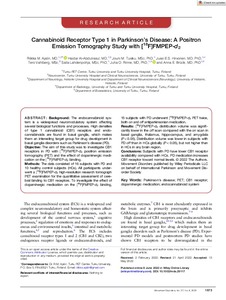Cannabinoid Receptor Type 1 in Parkinson's Disease: A Positron Emission Tomography Study with [F-18]FMPEP-d(2)
Ajalin Riikka M; Vahlberg Tero; Brück Anna E; Rinne Juha O; Hirvonen Jussi ES; Lahdenpohja Salla; Tuisku Jouni M; Al-Abdulrasul Haidar
https://urn.fi/URN:NBN:fi-fe2022081155060
Tiivistelmä
Background: The endocannabinoid system is a widespread neuromodulatory system affecting several biological functions and processes. High densities of type 1 cannabinoid (CB1) receptors and endocannabinoids are found in basal ganglia, which makes them an interesting target group for drug development in basal ganglia disorders such as Parkinson's disease (PD).
Objective: The aim of this study was to investigate CB1 receptors in PD with [18F]FMPEP-d2 positron emission tomography (PET) and the effect of dopaminergic medication on the [18F]FMPEP-d2 binding.
Methods: The data consisted of 16 subjects with PD and 10 healthy control subjects (HCs). All participants underwent a [18F]FMPEP-d2 high-resolution research tomograph PET examination for the quantitative assessment of cerebral binding to CB1 receptors. To investigate the effect of dopaminergic medication on the [18F]FMPEP-d2) binding, 15 subjects with PD underwent [18F]FMPEP-d2 PET twice, both on and off antiparkinsonian medication.
Results: [18F]FMPEP-d2 distribution volume was significantly lower in the off scan compared with the on scan in basal ganglia, thalamus, hippocampus, and amygdala (P < 0.05). Distribution volume was lower in subjects with PD off than in HCs globally (P < 0.05), but not higher than in HCs in any brain region.
Conclusions: Subjects with PD have lower CB1 receptor availability compared with HCs. PD medication increases CB1 receptor toward normal levels. (c) 2022 The Authors. Movement Disorders published by Wiley Periodicals LLC on behalf of International Parkinson and Movement Disorder Society
Kokoelmat
- Rinnakkaistallenteet [19207]
